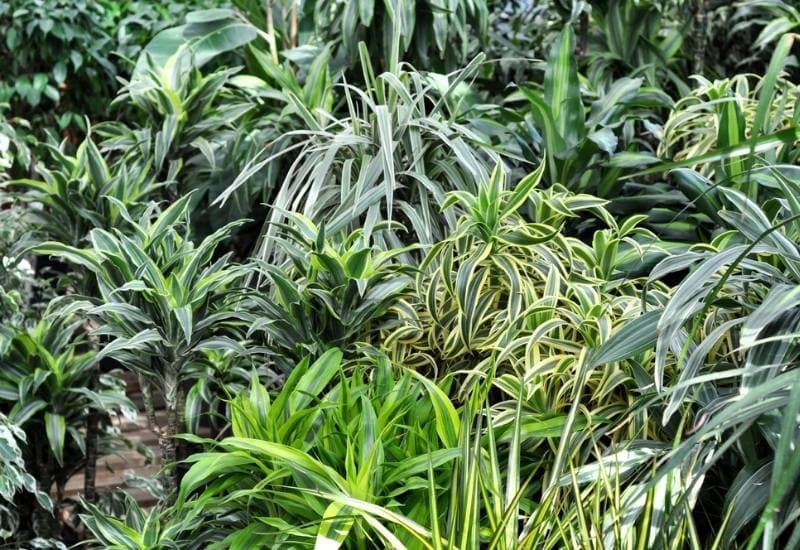
With its splendid lanceolate and arched foliage, showcasing modern often variegated hues atop a quaint solid trunk, the Dracaena plant exudes a touch of exoticism.
Native to the warm and humid regions of Asia, Central America, and certain tropical areas in Africa, Dracaena is a genus with about 120 species of evergreen flowering trees and shrubs in the asparagus family. From medium-sized trees like Dracaena draco to smaller perennials such as Dracaena trifasciata, also known as mother-in-law’s tongue, Dracaena plants come in diverse sizes, shapes, and colors.
These exotic plants typically have one or more trunks, bearing hard, pointed, leathery or waxy foliage, often arching, and shaped like swords or lances. A unique feature is their trunk, which thickens into a hard surface distinct from the bark of regular trees—it appears almost like hard paper or cardboard.
While they thrive outdoors in the tropics, many Dracaena varieties are also excellent houseplants. They adapt well to less-than-ideal conditions and are effective at improving indoor air quality by producing oxygen and removing toxins.
In the diverse world of Dracaena, each species unveils a kaleidoscope of colors and leaf patterns. You’re sure to find a variety that not only catches your eye, but also feels right at home in your space—be it the living room, office, or your outdoor garden.
Join me in exploring 14 captivating dracaena varieties, handpicked for both cozy indoors and lush outdoors. Don’t worry, I’ve got you covered with tips on how to identify and care for your leafy companion.
10 Types of Dracaena Plants You Can Grow Indoors
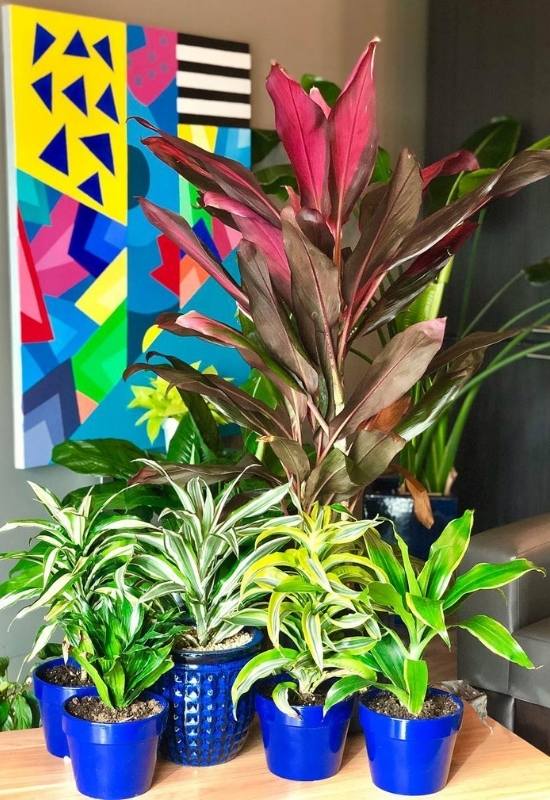
I’ve always admired Dracaena for its widespread popularity as an indoor plant. From the good luck charm of the lucky bamboo to the poised elegance of the dragon tree, these plants stand out.
With their lush, glossy foliage and graceful stature, they effortlessly add a touch of elegance. Even better, they ask for little in return when it comes to care.
You’ll often spot them gracing offices, enlivening living rooms, and adding a soothing, calm energy to enclosed spaces. Smaller varieties are a charming addition to table tops, while the larger, tree-like ones stand proudly in brightly lit corners, casting a tropical allure.
Here are 10 of our favorite indoor dracaena varieties to add a tropical feel to your home.
1: Corn Plant (Dracaena fragrans)
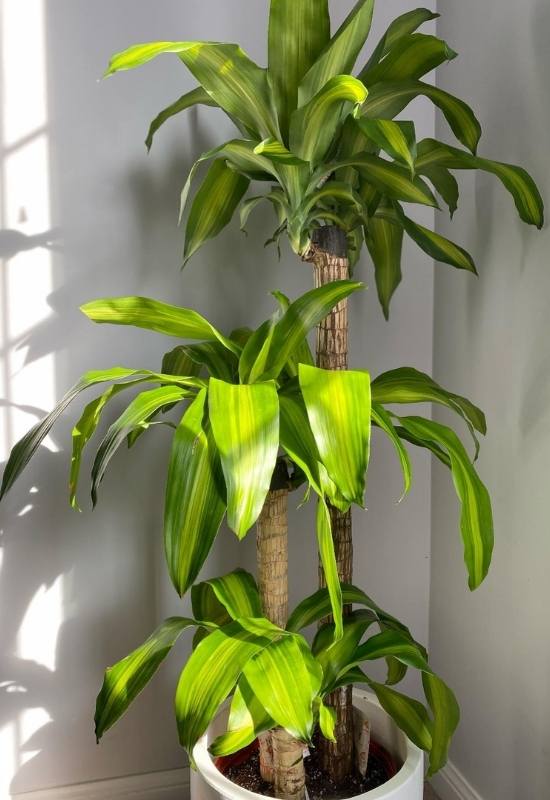
Adaptable and totally lush, Dracaena fragrans, commonly known as the Corn Plant is the most popular dracaena varieties, and a popular choice amongst house plants. The tall, stately Corn Plant can become quite big, but small specimens are common too.
It is ideal to purify the air, and this makes it even more valuable for indoor gardening. It has a straight trunk with rings along it, green when young and then it becomes like buff paper.
On the sides, it grows layered tufts of waxy lanceolate leaves that arch beautifully. It is very elegant, and there are a few varieties, some fully emerald green, others are variegated..
Corn plant derives its name from the leaves, that look like those of maize. It is a slow grower, so you can enjoy it in your desk for years before you move it to a floor pot to give your living room or office an exotic but also elegant look.
There are many cultivars derived from corn plant, and we will see the best, because it is a very common houseplant.
2: Lemon Surprise Dracaena (Dracaena fragrans ‘Lemon Surprise’)
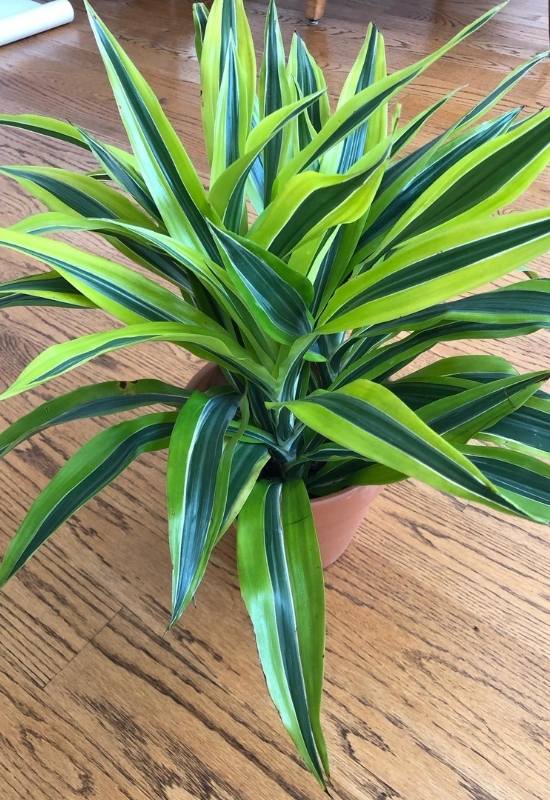
‘Lemon Surprise’ is a cultivar of corn plant you will identify at once; in fact its leaves twist sideways, giving you beautiful rosettes that look like whirlpools…
The foliage is very waxy and shiny indeed, and it has dark and pea to lime green stripes. These heighten the dynamic effect of this small houseplant. It is very sculptural and dramatic, and it looks good in small clumps too.
‘Lemon Surprise’ is perfect as a focal point on a desk, book case or coffee table. It is one of the most striking varieties of Dracaena on the market but it is not so easy to find it, your best choice is an online store, unless you have a well stocked garden center nearby.
3: Dracaena Lisa (Dracaena fragrans ‘Lisa’)
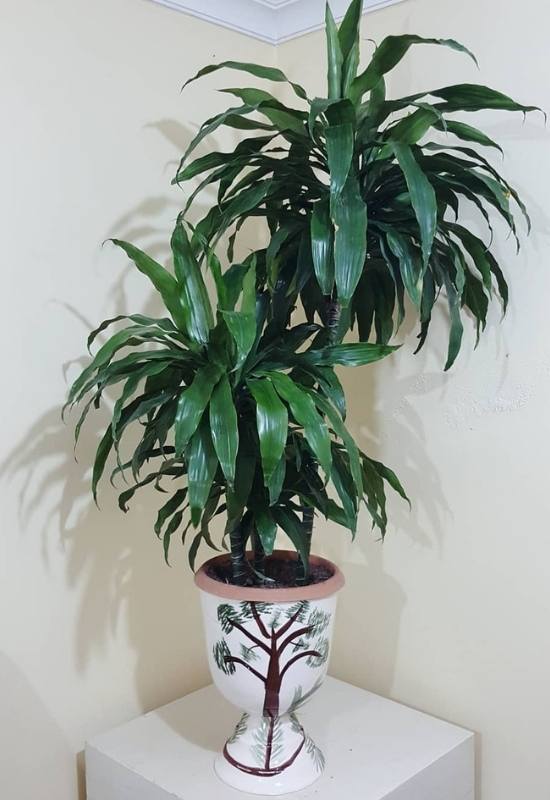
Dracaena Lisa has broad pointed leaves of the deepest and glossiest emerald color. They are quite hard to the touch, and they look like they are made of wax or plastic.
They grow in tufts with different layers that open from the center of the stem and keep and they keep straight when they are young, but they slightly arch when they mature. They can also have slightly twisted tips.
Dracaena Lisa is ideal for an exotic looking effect on desks but also as a floor plant, especially if you use it in compositions with other tropical houseplants, like bromeliads, philodendron and Alocasia.
4: Lucky Bamboo (Dracaena sanderiana)
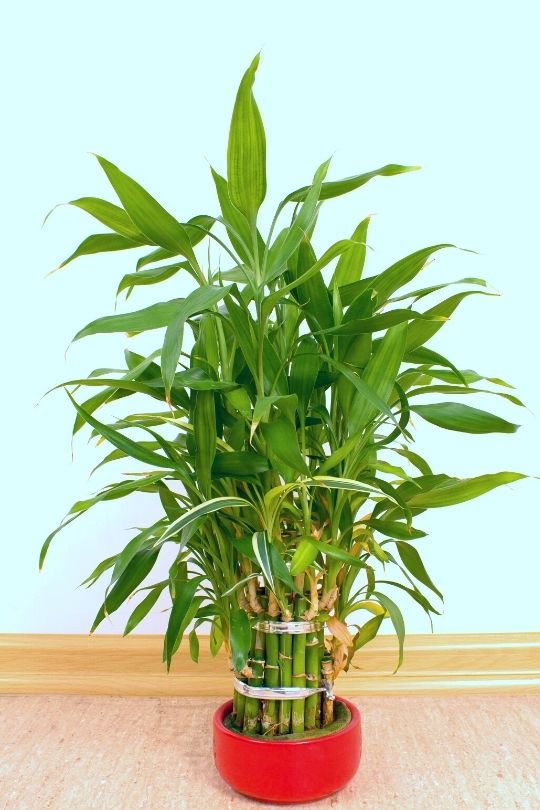
Lucky bamboo is a favorite Dracaena species from Africa for elegant, even minimalist indoor spaces. It has green and glossy stems with rings that grow upright, like bamboo indeed.
When cut, they produce a few leaves on the sides, with a very open and airy habit. These are lanceolate, shiny and they range from light to mid emerald green in color, depending on light and maturity.
You can train the stems around a stick to make them curl into spirals. It is also an excellent plant for hydroponics, and an elegant vase makes this plant stand out like a small living sculpture.
Lucky bamboo is ideal for tidy, light and refined indoor spaces; in working or living areas it brings a sense of oriental elegance and sophisticated elegance. It is easy to fond it, even in non specialistic stores.
5: Braun’s Dracaena (Dracaena braunii)
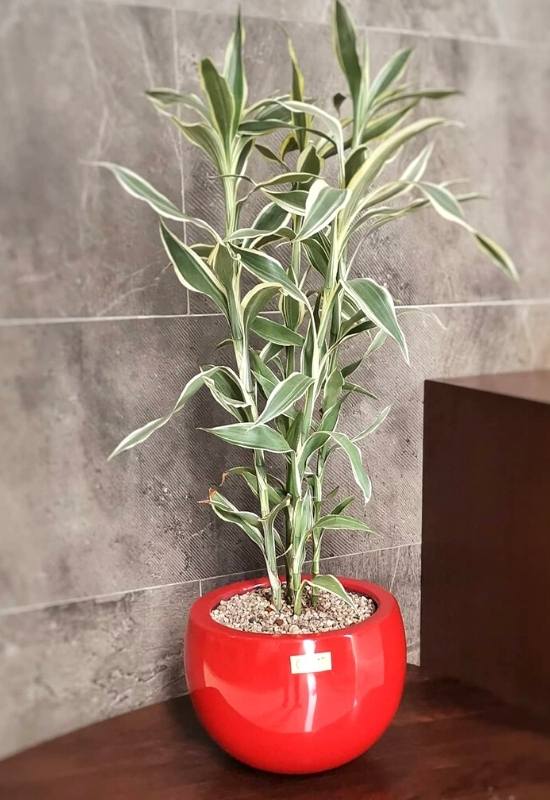
Braun’s dracaena is a distinctive species that looks like a herbaceous shrub, with foliage that reminds you of peace lilies.
Waxy like in other varieties, the leaves look thinner though still hard, and they start off very thin and then become broader in the middle to then taper to a pint at the end.
They will arch and have a horizontal direction and they are light green in color. This is one of the rare indoor types that will blossom willingly.
The white flowers have white petals that look like filaments, elegant and light, and they come at the top of a long, straight and upright stem above the plant.
Braun’s dracaena is related to lucky bamboo but it is not as popular with garden centers and retailers.
It is less elegant than other species, and for this reasons it suits a more informal room, especially in composition with other leafy and tropical plants.
6: Limelight Dracaena (Dracaena fragrans ‘Limelight’)
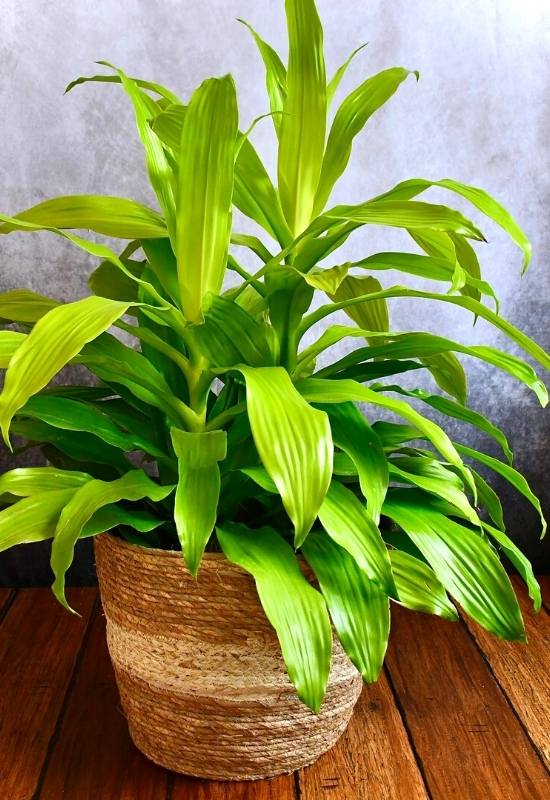
Limelight dracaena has a unique color: it is bright lime green, so bright that it looks like it shines! So you won’t find it hard to identify it.
The leaves are fairly broad, long and pointed, very smooth, like jade in fact, and they come in rosette like but fairly irregular tufts on top of the stems.
They start off upright and then they arch beautifully and deeply, so the overall shape is very soft and smooth.
The color is very stable too, even if light conditions change. Nd it tolerates darker places, unlike other varieties.
For this reason, limelight dracaena is ideal to bring light, vibrancy and vitality to darker indoor corners.
It is also very elegant and showy, so it will make a good show stopper where few other plants can thrive.
7: Dragon Tree (Dracaena marginata)
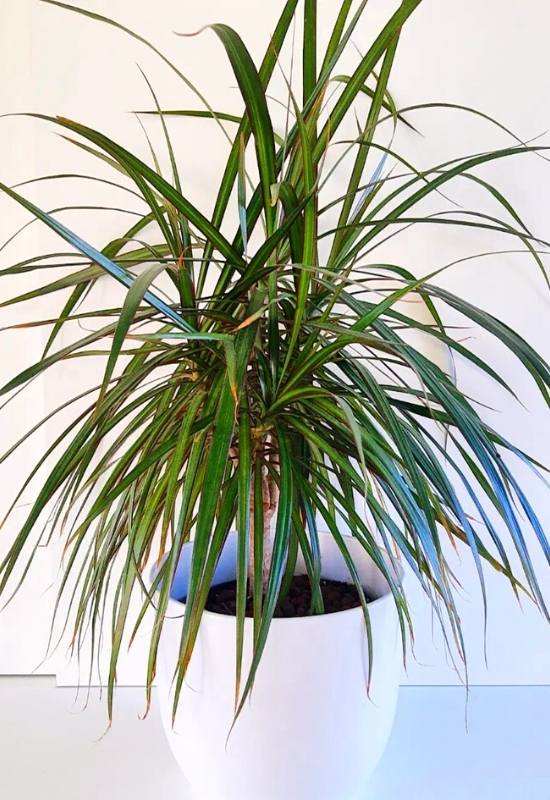
Dragon tree is one of the most sculptural varieties of Dracaena you can grow indoors. It has a fairly long straight upright stem; it is slender and smooth and it divides into two or three branches that are topped by beautiful rosettes.
The leaves are long, thin and blade like, and they are quite thickly packed and starting from a central point. When young, they keep straight while as they keep growing they arch, giving you a palm frond effect.
Each leaf is light green with thin maroon stripes at the margins. There are cultivars like ‘Tricolor’ with gold, purple and green stripes.
Dragon tree is like a small living statue for elegant indoor spaces, at home or at work. It is an ideal floor houseplant, and it suits brightly lit and tidy, empty spaces. You can have jt as a stand alone plant, even as a focal point, especially ‘Tricolor’.
8: Mother in Law’s Tongue (Dracaena trifasciata)
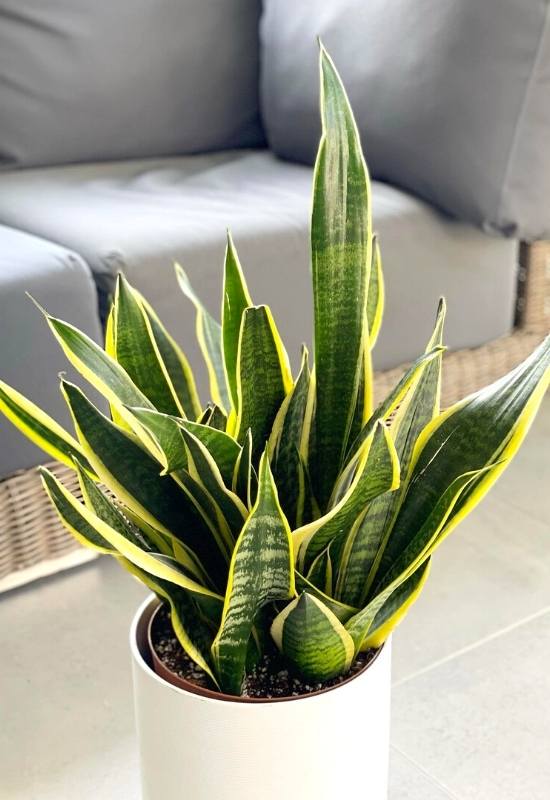
Mother in law’s tongue is a newcomer in the Dracaena but not t0 houseplant; in fact, it is the famous snake plant, or Sansevieria trifasciata.
Yes, they are the same plant, and it has recently been renamed and reclassified. It has long, blade like, hard and shiny leaves that grow upright but also bend and twist slightly before they end in a pointed tip.
It has two lime green to almost yellow stripes at the sides and an amazing snakeskin dark and light silver green patches in between.
Snake plant, or mother in law’s tongue is a very popular houseplant; it looks like a modern marble sculpture and it can brighten up even the dullest indoor space with its amazing personality. It is a winner of the Award of Garden Merit by the Royal Horticultural Society.
9: Gold Dust Dracaena (Dracaena surculosa)
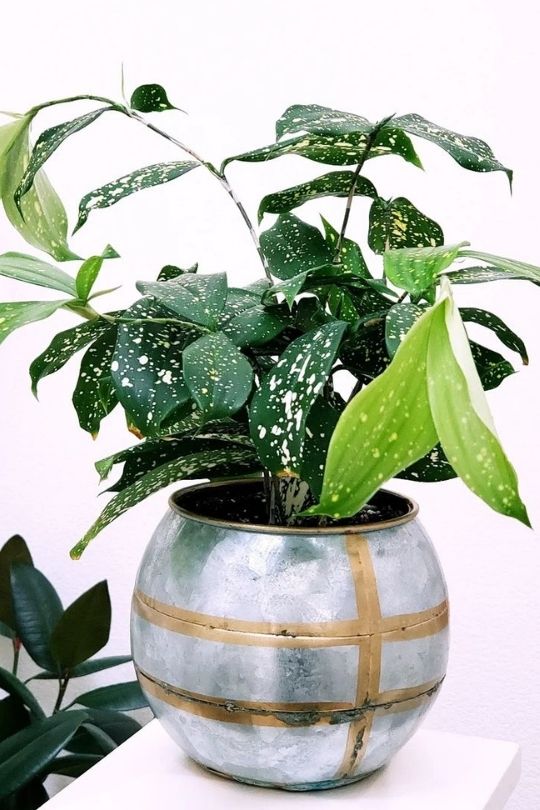
Gold dust dracaena also known as Florida beauty is an unusual and variegated varieties of dracaena with thin arching stems and bright showy foliage, comes from Africa. It has distinctive look, so it’s easy to recognize.
It almost looks like a shrubby vine, with long, tender looking and thin stems that grow upright and sometimes outward. The leaves are broad and elliptical, horizontally places and variegated. The exact pattern depends on the cultivar you choose.
‘Milky Way’ has a central cream patch with dark green margins, sometimes spotted. ‘Florida Beauty’ has lots of white to cream yellow and emerald to dark green spots, with a prevalence of the brighter shades; this has won the Award of Garden Merit by the Royal Horticultural Society.
The mother species has emerald green leaves with lime green spots. It will also blossom, with beautiful but small spider shaped white flowers.
Gold dust dracaena has a very tropical look, lush and typical of rain forests. It is a beautiful florid centerpiece for tables and you can also have it in the floor as it grows up.
10: Green Zebra Plant (Dracaena goldieana)
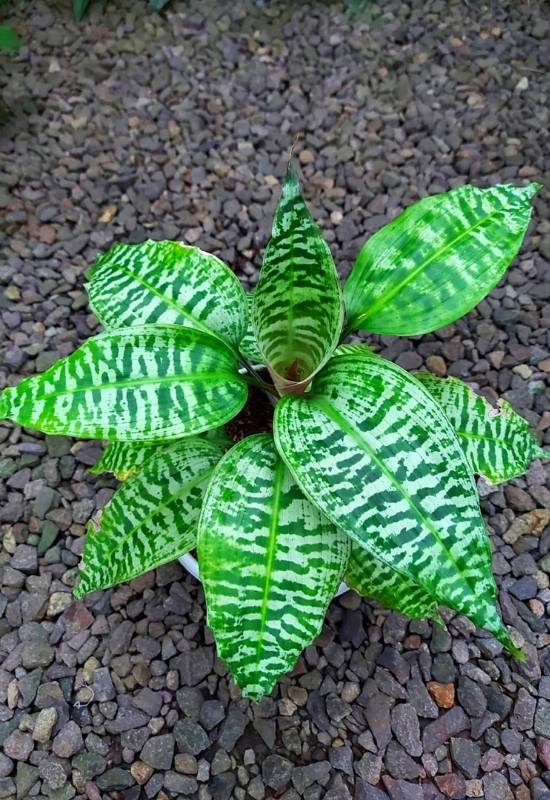
Green zebra plant is true to its name! This Dracaena has broad and pointed horizontal leaves with pale silver green and bright emerald to dark green stripes and patterns, just like the famous African herbivore.
They are big, almost a foot long (30 cm) and 6 inches wide (15 cm), and they open alternately on the upright stems, with regular intervals and a star shape if you look at them from above.
Glossy and very showy, they are the main feature of thus beautiful tropical forest plant. The exact shades can vary with the light, as it adapts to darker places, because in the wild, it is natural groundcover under the thick canopy of tall and thick trees.
Green zebra plant is a rare beauty and it is becoming more popular with garden centers. It is ideal for a lush and luxurious room where you want a lot of green foliage and a very exotic design.
4 Great Dracaena Plant Varieties to Grow Outdoors
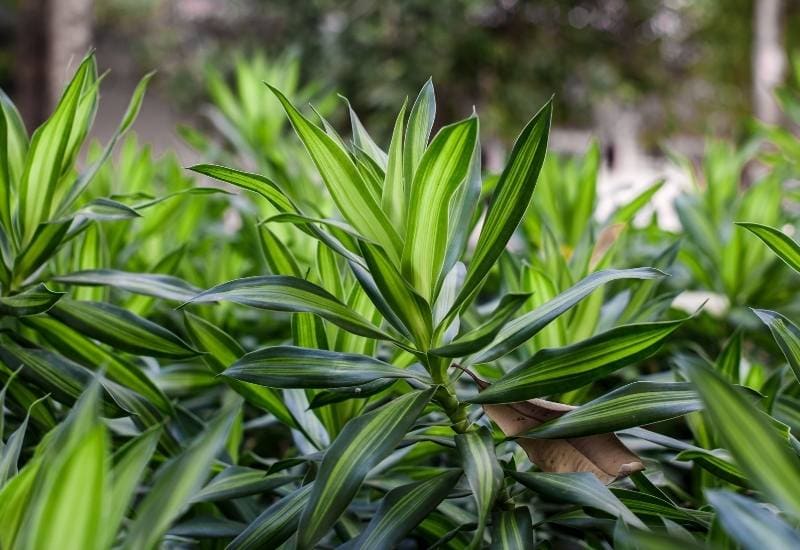
There are also a few varieties of Dracaena that you can grow outdoors, some because they are big, and others because they prefer fresh air.
If you live in the right climate, you could also grow the ones we have seen so far in the open, or take them it when its warm. Still, for the very best varieties to grow in gardens and on terraces, here is a great selection.
11: Song of India ‘Variegata’ (Dracaena reflexa ‘Variegata’)
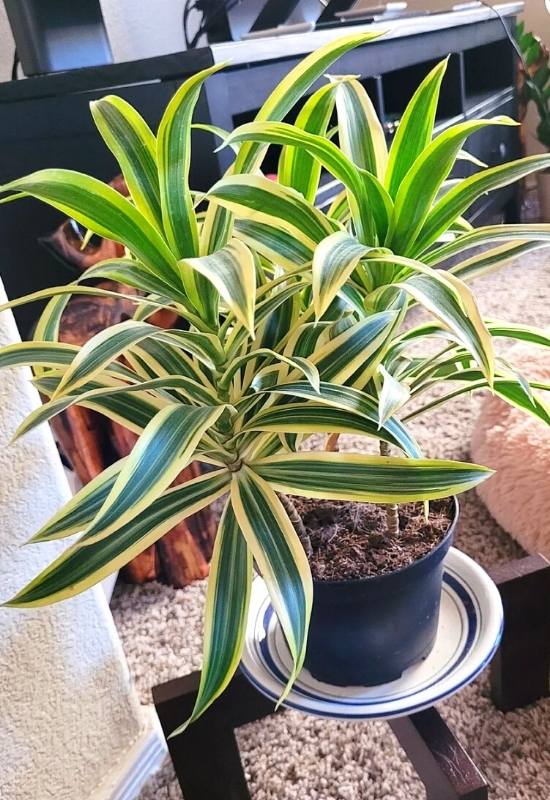
Song of India is a very lush variety of outdoor Dracaena, and the ‘Variegata’ cultivar has the extra factor of bicolor leaves.
With emerald green in the middle and cream yellow stripes at the margins, they are smooth and glossy, with a lance shape and often slightly twisting pointed tips.
They grow densely and in spirals along the stems, which appear completely covered by the rich foliage.
It is a succulent shrub like beauty which will also produce flowers and berries if you grow it outdoors.
It has received the Award of Garden Merit by the Royal Horticultural Society. The mother species has the same shape and look, but the leaves are all green.
Song of India and its ‘Variegata’ variety are ideal for a foliage rich bush effect in full soil or containers outdoors, especially for exotic, tropical and Mediterranean garden designs.
12: Red Blood Dragon Tree (Dracaena draco)
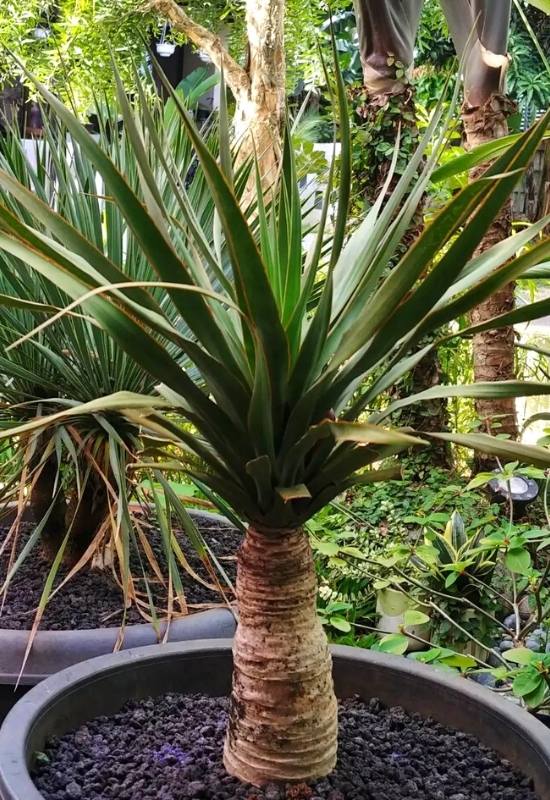
Red blood dragon tree is a majestic species of Dracaena for large and sunny outdoor spaces. It grows like a tree with soft looking trunk and branches, that appear covered in a warm light brown paper peel.
The branches start off above your head and they are very dense, forming an umbrella that ends in a tufty “roof” of many pointed, blue green succulent blades, that look a bit like the arms of octopi.
The crown is flat and disk shaped, providing lots of shade as well as a real protagonist to any green space. Sometimes you also get crimson stripes on the trunk, if you cut it, because the sap of this large dracaena is of this amazing bright color.
It will blossom in summer with panicles of white to greenish flowers and they turn into beautiful and bright orange berries.
Dragon tree is a show stopper for Sun bathed gardens only, especially Mediterranean, desert and xeric ones, but even in tropical designs it could find an excellent place. It has won the Award of Garden Merit by the Royal Horticultural Society.
13: African Dragon Tree (Dracaena arborea)
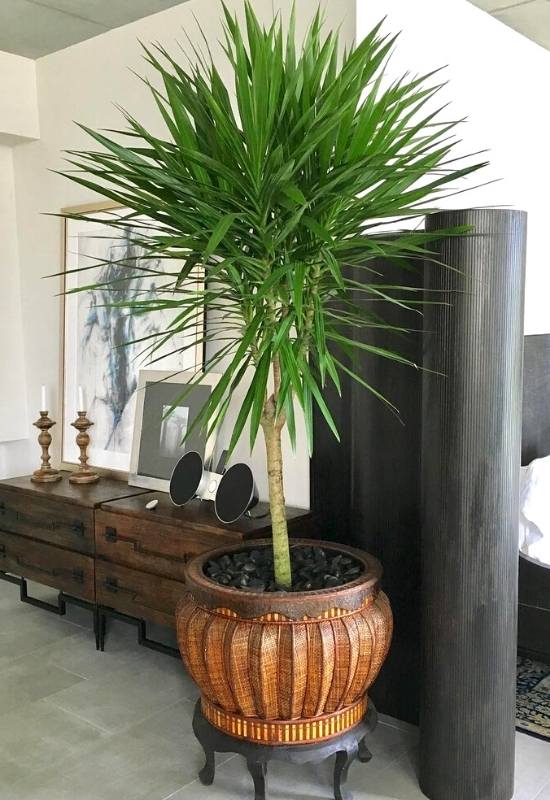
African dragon tree is easily identified in the Dracaena genus because it looks like a palm. It grows thin, upright and straight trunks, light brown in color and with thin horizontal stripes that look like cuts on paper.
When young, it will have a single rosette of hard, pointed, smooth and blade like leaves that form a deep green globe or pom pom in the sky.
As it becomes older, small and lean branches will appear, and you will have a few of these sculptural crowns forming a tropical island looking tree, or even a prehistoric one.
While it is not one of the most popular varieties, experts say that African dragon tree has a great future.
In fact African dragon tree is ideal for poolside settings, Hollywood or tropical island themes, for bright Islamic or Mediterranean gardens and it is so elegant and sculptural that it will even suit a formal design and public parks. And you can grow it in containers too.
14: Socotra Dragon Tree (Dracaena cinnabari)
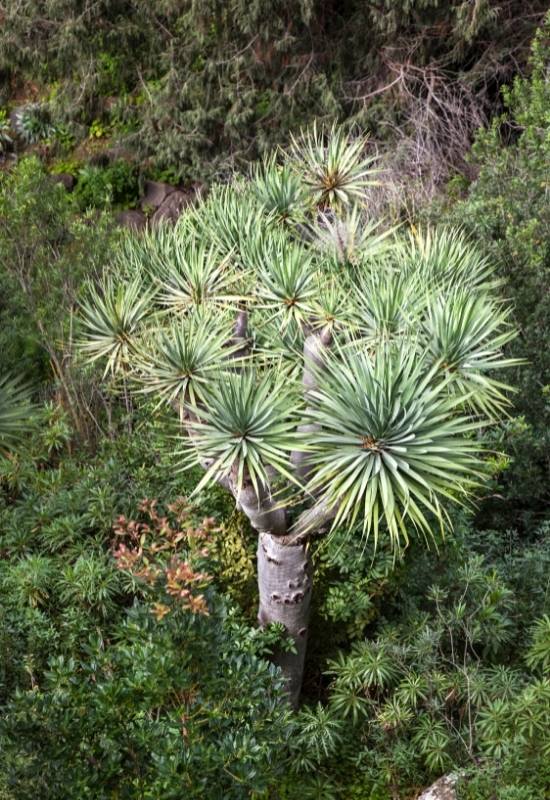
Socotra dragon tree is an extraordinary variety of Dracaena for outdoor growing that looks like a massive mushroom. You can’t confuse it! The large trunk is covered in a light beige green paper like peel, and it stays single when the plant is young.
But at a certain height, it will spread out into thickly packed horizontal branches that form what looks like a ceiling with fine twisting relief work.
On top, you get a dome, like with mushrooms, indeed, and it is made up of a thick, deep green canopy of hard and strong leaves that form tightly packed rosettes of curved blades.
Seen from above, it looks like a carpet, or a well manicured lawn… The blooms appear in summer on top of this unusual crown, adding patches of sweet scented lime green inflorescences. Later in they will turn into bright red berries,madding another spectacle till late fall.
Socotra dragon tree is ideal as a jaw dropping specimen plant in a garden where you want to wow your visitors; you will need lots of space, and it suits dry looking themes, like xeric, desert and Mediterranean gardens.
Dracaena Plants For Rooms And Gardens
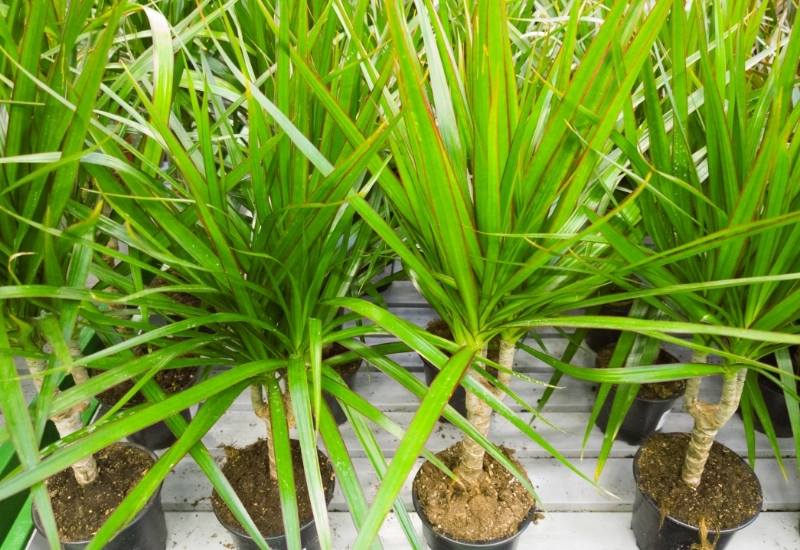
Dracaena plants are not only small lucky bamboo sticks you can grow in a jug… There are even real absurd looking giants, colorful plants, and even vine looking ones.
Some will do well indoors unless you live in Florida or Sicily, while others can only grow outdoors, because they are big and they like open spaces. But now you know the very best for you.

Written By
Amber Noyes
Amber Noyes was born and raised in a suburban California town, San Mateo. She holds a master’s degree in horticulture from the University of California as well as a BS in Biology from the University of San Francisco. With experience working on an organic farm, water conservation research, farmers’ markets, and plant nursery, she understands what makes plants thrive and how we can better understand the connection between microclimate and plant health. When she’s not on the land, Amber loves informing people of new ideas/things related to gardening, especially organic gardening, houseplants, and growing plants in a small space.

Very informative…I learned a lot from this article
i have a seven foot draconian plant to big now for the house . How can i cut it to make three more plants . the stalks are so big